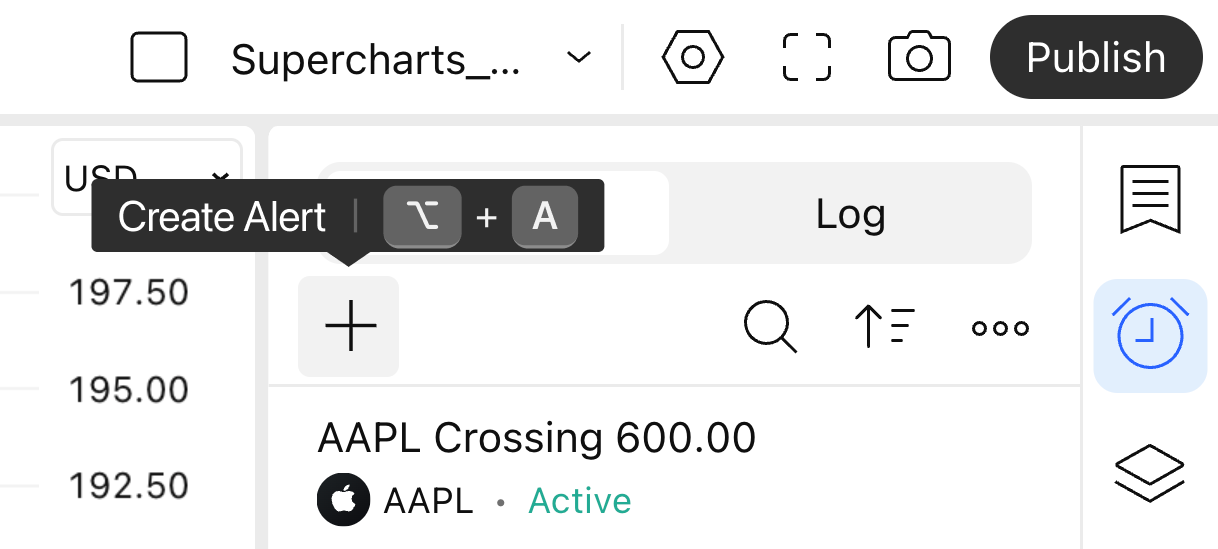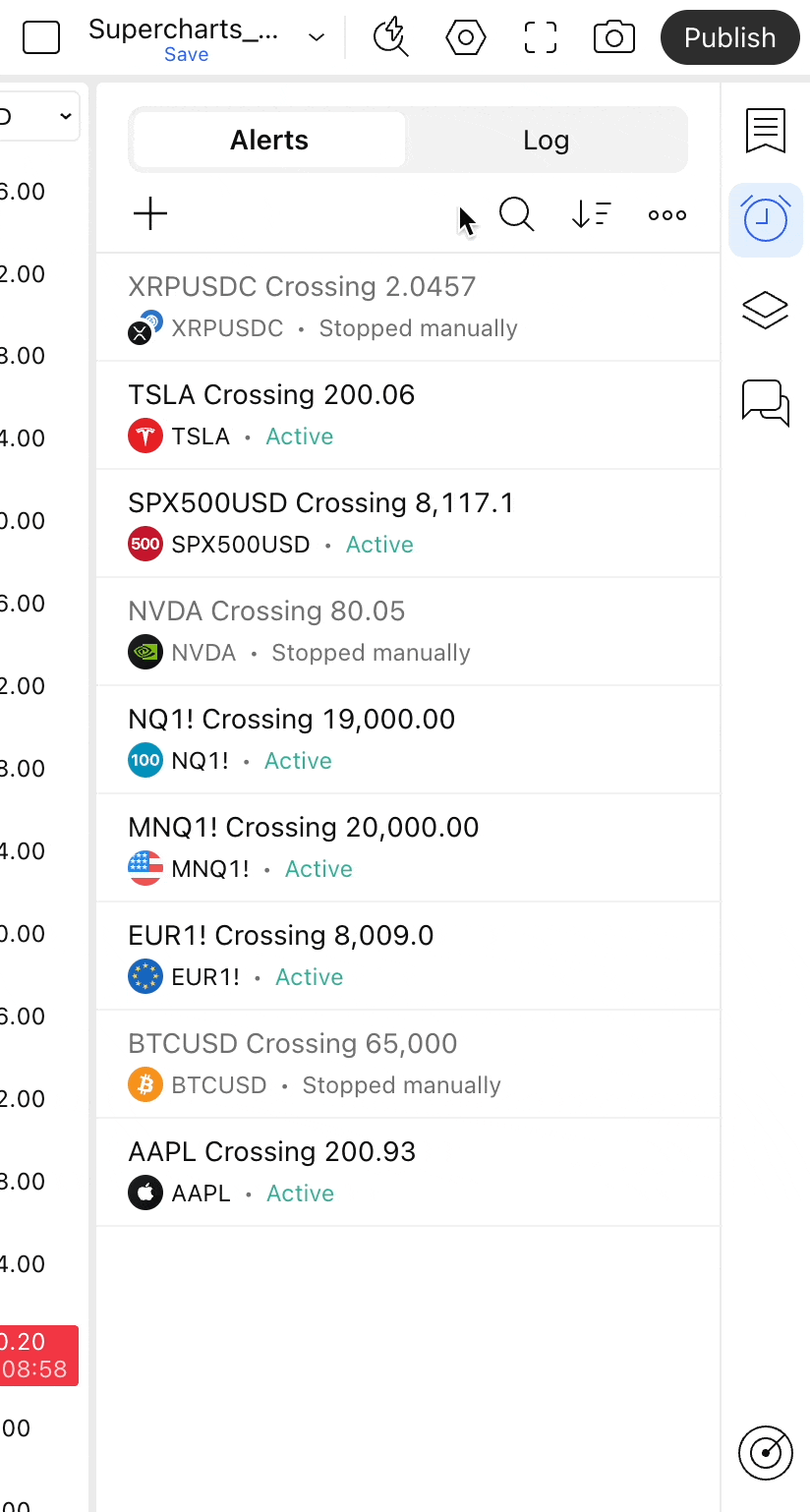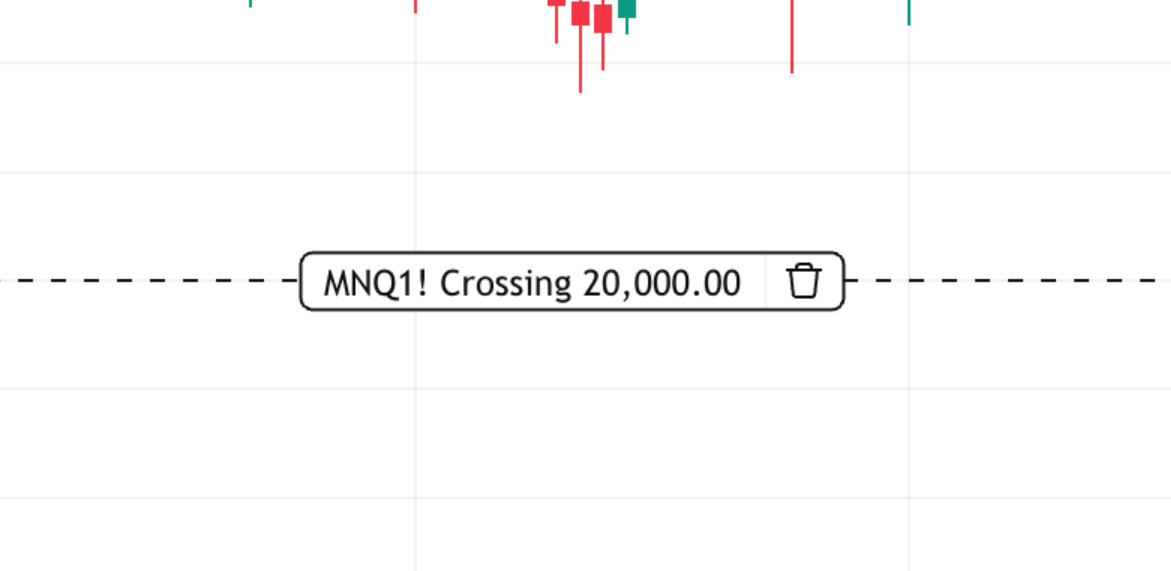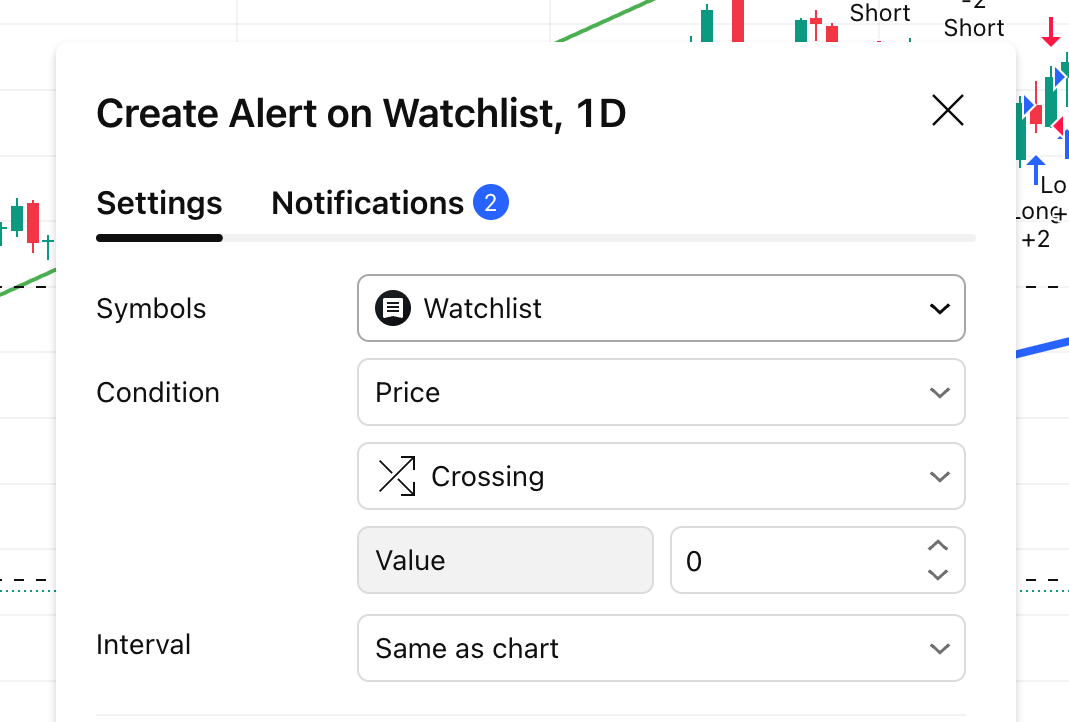Alerts: how to get notifications immediately
Alerts help traders and investors stay on top of key market events by sending timely notifications. They might be super simple — for example, to track when Bitcoin will reach a certain price. Or very complicated — like the ones based on complex indicators and strategies with multiple calculations. But, they’re always easy to use, and we’ll show you how.
All these alerts are available on TradingView. In this article, you will learn everything about the TradingView alert system: how to create and use alerts, what types are available, and many other things along the way.
CONTENTS
- Why traders can’t do without alerts
- Technical and price alerts: what’s the difference
- Which types of triggers you can pick
- How to create alerts on TradingView
- Must-know alert settings
- How to receive alert notifications
- How to manage all your alerts
- Alerts on indicators
- Alerts on chart patterns
- Alerts on Pine scripts
- Alerts for strategies
- Alerts on drawing tools
- Alerts on watchlists
- Second-based alerts
- Shortcuts: how to manage alerts faster
Why traders can’t do without alerts
Let’s briefly talk about the key benefits of TradingView’s alerts.
- Alerts instantly notify about an event. This enables traders to react to market changes in an instant.
- They are precise and efficient. Our alerts run on powerful servers. This makes them fast and robust.
- You save your time and automate your strategies. You don’t need to spend valuable moments tracking market movements.
- TradingView’s alerts are available on every device. Web-version, desktop, and mobile apps — you can pick only one or everything at once.
- Alerts help to learn and analyze. Analyzing alerts allows us to understand the market's reaction to various events. This is useful for learning and improving strategies.
- You can customize alerts as you want. Our alerts have multiple built-in and advanced conditions to set them up for your needs. They’re also very easy to use.
- They can be created on Pine scripts. You can set up complex alerts using Pine Script — TradingView’s programming language for traders.
Technical and price alerts: what’s the difference
Which types of triggers you can pick
When setting up an alert, you’ll need to define the conditions that trigger it. Here’s a breakdown of what you can do.
Crossing — the most common alert type used. It triggers when a price crosses a specific value — and this can be in either direction.
Example: Alerts when BTC crosses $30,000
Crossing up / crossing down — these are directional variations of the crossing trigger above. You can specify whether the price will cross the value when moving up or down. Cross up triggers when the current price series crosses the lower value set in the notification, while cross down triggers when the price crosses the upper value.
Example: Alerts when BTC crosses $30,000 upwards or downwards
Greater than / less than — these conditions are used when you want to know that the price not only reached a specific point but surpassed or fell below that mark. Greater than notification triggers when the price series reaches a higher value than set in the alert. Similarly, less than notification triggers when the series reaches a lower value than set in the alert.
Example: Alerts when BTC is greater or less than $30,000
Entering channel / exiting channel — channels are boundaries above and below a specific price. Typically, channels arbitrarily define price volatility for a stock, and movement beyond channel boundaries is considered significant or non-standard price movement. Channel entry notification triggers when the series enters the channel set in the alert. Channel exit triggers when the series exits the channel.
Example: Alerts when BTC enters the $30,000–$35,000 channel
Inside channel / outside channel — the inside channel condition triggers if the series value is within the channel, while outside channel notification triggers when the series value goes beyond its limits. The value must be set when creating the notification.
Example: Alerts when BTC is within the $30,000–$35,000 channel
Moving up / moving down — this is almost the same condition as сross from below / cross from above, one with an additional parameter — time. The notification will trigger if the stock price moves up by $X within a specified period (i.e., bars). Up movement notification triggers if the price rises by a predefined value within the specified number of bars. Down movement notification works on the same principle but with a decrease in price.
Example: Alerts when BTC moved up or down by 1,000 in 5 bars
Moving up % / moving down % — up movement % notification works on the same principle as the type described above, but values are specified in percentages. It triggers if the price rises by a certain set percentage. Down movement % notification triggers when the price decreases by the specified percentage.
Example: Alerts when BTC moved up or down by 1% in 5 bars
Drawing tool notifications — the types of available notifications depend on the drawing tool.
- For "line" type drawing tools, the following conditions are available:
- Crossing
- Cross from below / cross from above
- Greater than / less than
- For "channel" type drawing tools, the following notifications are available:
- Channel entry / channel exit
- Inside channel / outside channel
- Notifications are not provided for "fork" type drawing tools.
If there is an active notification on the chart, you will see an icon next to it (in the same color as the drawing tools). When the notification becomes inactive, the icon will turn gray. If the drawing tool is changed, the notification will automatically adjust.
How to create alerts on TradingView
There are several ways to set an alert:
1. By hotkeys: ALT + A (Windows) or ⌥ + A (Mac)
2. The button on the top toolbar

3. The button in the alert manager window

4. From the right-click menu

5. The button on the drawing panel. Note that this option is only available for lines, channels, and AVWAP.

6. The Plus button next to the current price on the price scale

Alerts can be created on data series, indicators, chart patterns, indicators, strategies, and drawing tools. On data series, alerts are independent of time intervals, while other types of alerts do depend on the interval because it’s taken into account when calculating indicators.
NOTE! If you change an indicator’s parameters after an alert is created, then the alert will be triggered using the old settings.
Must-know alert settings
There are plenty of settings you can use when creating a new alert or changing the existing one.
1. Condition. Determines when the alert will trigger.
2. Frequency. Specifies how often the alert will be triggered.
3. Expiration. Automatically stops the alert when the timer expires.
NOTE! Essential, and Plus subscriptions allow notifications to remain active for up to two months. After that, they will automatically be paused. No such restrictions exist for Premium and higher subscriptions.
4. Alert name. The title displayed in the alerts' manager to easily identify alerts.
5. Message. Shown when an alert is triggered. You can use special placeholders to access variable values in the alert's message.

How to receive alert notifications
You can always choose how and where you want to be notified when an alert is triggered.
Notify in app — to get notified with an alert on your phone, download the latest TradingView app from the AppStore or Google Play.
Show toast notification — a pop-up message will appear once an alert is triggered. If this option is enabled, a pop-up message will appear, even if you are browsing in another tab. Note, for this feature to work properly, please allow TradingView to show desktop notifications.
Send email — an email will be sent to you when an alert is triggered. We’ll use the email address from your TradingView profile.
Webhook URL — webhooks allow you to send a POST request to a certain URL every time an alert is triggered.
Play sound — once an alert is triggered, you’ll hear a sound notification.
Send email-to-SMS — a free method for sending text messages to your phone. This site aims to be the most complete and up-to-date list of international email providers that can be used to send text messages to phones.

How to manage all your alerts
Click on the alarm icon on the right panel to open the alerts manager. This tool helps you to navigate and modify your alerts. You can personalize the list by selecting the alert view. Click on the Options button (three dots) and check the items in the Customize list that you want to see.

Alerts can be sorted by Ticker, Name, Message, Date created, or Time triggering. Click on the Sorting button and select your preferred order.

Use the control keys in the list to pause, restart, edit, or delete alerts.

Right-clicking on an alert will open the context menu with the same options.

Double-click an alert to open its Edit menu.
After creating an alert, a mark specifying its level (except moving alerts), will appear on the chart. Hover your cursor over the mark to see a tooltip with a description.

Double-click on the mark to view the Edit Alert menu, and right-click on the mark to add or delete an extended alert line.

You can also edit the alert value directly — simply drag the label to where you want it to be. Once you move it to the desired place on the chart, the new value will automatically be applied in the Edit dialog window.
When the alert is triggered, the corresponding label will start blinking on the chart.
All triggered alerts are automatically added to the Alerts Log. Here, you can access your alert history anytime. Click on the Log and use the keyboard arrows or Space bar to move between the triggered alerts.
You can customize the log list, clear the log, or export it to a CSV file — the choice is all yours. Click on the Options

Alerts on indicators
You can set alerts for over a thousand TradingView indicators, including community-created ones. You can customize each notification precisely as you need with conditions like "Crossing Up" or "Exiting Channel" or define your own trigger settings using alertcondition and alert functions.
To set up an indicator alert, open the Create Alert dialog, select the script in the Condition field, and choose a built-in preset or customize your own condition.
NOTE! If indicator parameters are changed after an alert is created, then the alert will trigger using the old settings.

Alerts on chart patterns
You have the ability to set alerts for various patterns — for example, to stay updated on new patterns, identify wedge breakouts, recognize double top formations, or get notified about a new Elliott wave.
To set up a chart-pattern alert, ensure that a chart pattern is added to the chart. Then, navigate to the Alerts menu, choose the desired pattern, and specify the conditions you want.

For more details on patterns available on TradingView, refer to our Chart patterns article in the Help Center.
Alerts on Pine scripts
For advanced customization, traders can configure alerts using Pine Script — TradingView’s programming language for traders. You can configure a script alert on Pine Script when the code contains calls to the `alert()` function. From the chart, create an alert using the “Create Alert” dialog box and select that indicator or strategy in the “Condition” field.
Contrary to other types of alerts, the triggering frequency and the message sent with script alerts are controlled by the `alert()` function calls in the script - not through the “Create Alert” dialog box. Script alerts on indicators will trigger when the conditions used with the script’s `alert()` function calls are met. Script alerts on strategies allow for the inclusion of order fill events, `alert()` function call events, or both.
You can read more about script alerts in our Knowledge base. Also, if you want to dive deeper into using the `alert()` function in scripts, use the Pine Reference Manual and the Pine User Manual.
Alerts for strategies
To create a script alert for a strategy, select the strategy in the Create Alert dialog box’s Condition field, then select one of the options below.
- Order fills and alert() function calls. The created alerts will trigger on order fills and `alert()` events.
- Order fills only. The alert only triggers on order fills, like an ordinary strategy alert.
- alert() function calls only. The alert only triggers on `alert()` events, like a script alert on an indicator will.

Alerts on drawing tools
To create an alert for a drawing, use the Add Alert button on the drawing panel. You can create alerts for “line” and “channel” drawing tools, for example, for a trend line, as shown in the screenshot below.

Alerts on watchlists
Set up Watchlist Alerts to monitor custom conditions over various symbols in your watchlist. Once a condition is met, you’ll receive a notification.
The ‘Add alert on the list’ button can be found in the ‘Settings’ of the ‘Watchlists’ section.

You can also select your watchlists directly from the ‘Symbols’ dropdown.

When an alert goes off, it specifies exactly which symbol from your watchlist triggered the alert.
Second-based alerts
You can create alerts for prices, indicators, and specific drawing tools in a way that notifications for triggers come every second.
However, for Essential, and Plus subscriptions, alerts on second charts are not available. This feature becomes accessible only after upgrading to a Premium pricing plan or higher.
Shortcuts: how to manage alerts faster
You can see hotkeys in the picture below or check them on the Keyboard shortcuts page.
